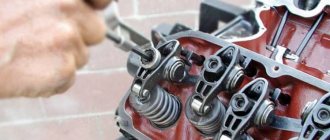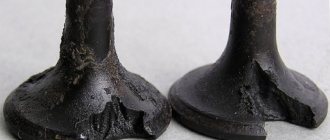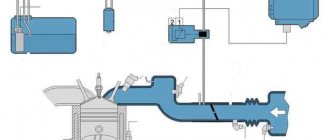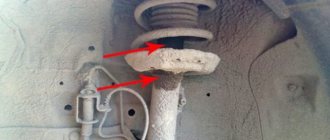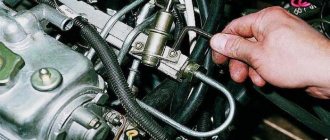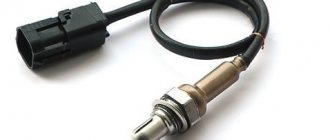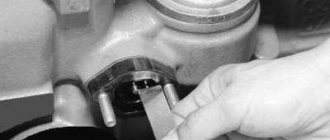The Exhaust Gas Recirculation system (EGR) is a solution that reduces the level of nitrogen oxides in the exhaust gases of a gasoline or diesel engine. This system, as applied to modern internal combustion engines, is absent only on gasoline turbo engines.
Diesel engines have different emission standards. For this reason, EGR of a diesel engine can be implemented according to various schemes. The USR exhaust gas recirculation system of a diesel engine can be:
- high pressure system;
- Low pressure USR;
- combined EGR system;
We also recommend reading the article about the features of operating a diesel engine in winter. From this article you will learn about additives in diesel fuel, glow plugs, heating diesel fuel, as well as preventive measures for confident starting of a diesel engine at subzero temperatures.
That's why you need to take the EGR valve seriously: it's small and clever.
If the EGR valve stops working correctly, then certain symptoms may appear in the car, clearly indicating to us that the exhaust gas recirculation system is faulty. Fortunately for you and me, most often this does not mean that it is time to change the valve itself. In many cases, we can easily fix everything ourselves.
Symptoms of EGR problems
On diesel engines, as well as on gasoline engines, there are two main types of EGR system problems. In the first case, the valve does not close, or it burns out and cannot block the flow of gases, and in the second case, on the contrary, it does not open. It also happens that the tube itself becomes clogged and although the valve opens and closes properly, gases do not enter the engine. Less often, the control element of the EGR system fails, but here it is much more difficult to determine the failure.
Problems with the exhaust gas recirculation system are expressed by the following symptoms:
- clicks and knocking;
- failures in engine operation;
- power drop;
- the appearance of errors for no apparent reason;
In the event that you have been diagnosed with some kind of breakdown of the EGR system, you can either repair or change this system completely or some of its components, or turn off the EGR.
There is information that diesel engines with the exhaust gas recirculation system turned off run much longer, precisely because less soot, dirt and other obscenities get into them. And some craftsmen have learned to turn off this system during the warm season, and turn it on in the winter, when EGR brings serious benefits. And this, albeit in some way, half-hearted solution also has a right to life.
Exhaust gas recirculation in diesel and gasoline engines
At first glance, it may seem a little strange to us that the engine exhaust gases do not always and immediately exit completely through the exhaust pipe. In fact, these waste gases are returned back to the engine. This technical trick lowers the combustion temperature of diesel fuel, which subsequently reduces the formation of harmful substances such as nitrogen oxide (NOx). Recirculated exhaust gases displace fresh air in the intake duct, i.e. those low oxygen levels in the exhaust gases then absorb some of the heat of combustion in the combustion chamber, resulting in a significantly reduced combustion temperature. As a result, the formation of harmful nitrogen oxide drops sharply.
This EGR valve is controlled by vacuum.
When the valve (inside) opens, it clears the way for exhaust gases to enter the intake duct. See also: New law on control over technical inspection from January 1, 2022
Gasoline engines also use an exhaust gas recirculation system. Here, the return of exhaust gases to the engine serves to reduce the fuel consumption of the vehicle, since the throttle valve can be further opened due to pressure from the returned exhaust gases. In this way, the so-called energy losses when opening the throttle valve are reduced, and this helps to reduce fuel consumption and, accordingly, leads to a decrease in the level of harmful substances in the exhaust system itself.
Removing the USR system and possible consequences.
The operating time of the USR system is limited by its service life. The need to replace the valve is the main reason many drivers refuse to use it. Other reasons for removing the EGR valve include:
- expensive repairs and maintenance of the unit;
- difficulty of maintenance;
- the risk of breakdown of even more expensive engine parts due to improper operation (breakdown) of the recirculation system;
- Removing the EGR valve does not affect the operation of the engine in any way.
Problems with the recirculation system are most often associated with fuel quality. When operating a car using diesel or low-purity gasoline with a high percentage of sulfur and additives, drivers have to visit a service center to prevent and clean carbon deposits up to 1-2 times a year. For a car enthusiast in this situation, it is easier to get rid of the device that causes so many headaches.
Some car owners practice self-disabling the system at the physical level using special gaskets (covering the valve holes). However, this method is only fully suitable for old diesel cars with a pneumomechanical drive.
In modern technology with an electro-pneumatic or electronic control circuit, along with installing the gasket, the valve is additionally removed and the unit is switched off programmatically.
The undoubted advantages of removing the exhaust gas recirculation device include the following points:
- the intake manifold is not contaminated;
- exhaust smoke is reduced;
- power increases at medium speeds;
- there is no need for maintenance and replacement of expensive components;
- it becomes possible to remove the engine power limitation.
Minuses:
- the ignition temperature of the fuel increases;
- the content of nitrogen oxide in the exhaust gases increases.
Consequences of abandoning the EGR valve:
- detonation appears at certain speeds;
- oil consumption increases;
- there is a risk of microdamage in the cylinder head.
Internal and external exhaust gas recirculation
Internal combustion engines (ICEs), as a rule, have two exhaust gas recirculation systems, i.e. – internal and external. The internal engine exhaust gas recirculation system does not require additional components, as it is implemented by the design of the power unit itself. Thus, during engine design, engineers adjust the timing of the valves so that they remain open for some time at the beginning of the intake stroke. As a result, some of the previously released exhaust gases are sucked back into the combustion chamber.
With external exhaust gas recirculation, the exhaust gases are directed into the intake channel through the external exhaust gas system pipeline (EGR-EGR system). Many diesel and some gasoline engines use an EGR aftercooler. This cooler cools the exhaust gases using antifreeze (coolant), which significantly lowers the temperature of the exhaust gases, leading not only to a decrease in fuel consumption, but also to a significant reduction in the level of harmful substances in the exhaust system of the car itself (the combustion temperature decreases).
What is a car exhaust system?
An exhaust system means a set of pipes of different lengths and diameters, as well as volumetric containers, inside of which there are barrier elements. It is always installed under the car and connected to the exhaust manifold.
Thanks to the different designs of the tanks (main muffler, resonator and catalyst), most sounds generated as a result of the operation of the power unit are damped.
Function of the EGR (exhaust gas) valve
When and in what quantities exhaust gases are sent to the external gas recirculation system is regulated and controlled through the exhaust gas recirculation valve - often called the exhaust gas recirculation (EGR) valve - or EGR.
The EGR valve usually consists of a poppet valve or a special gate valve. This valve releases or prevents the movement of exhaust gases into the engine intake tract.
Using sensors such as the mass air flow sensor and the oxygen sensor (lambda probe), the engine control unit calculates the ideal amount of exhaust gas recirculation and accordingly controls the exhaust gas recirculation valve (EGR valve).
The mechanical movement of the EGR valve device is usually performed electro-pneumatically or electrically using a servomotor.
On some vehicle models, the EGR valve is also equipped with a position sensor that monitors the correct opening and closing of the flap or pushrod. By the way, exhaust gas recirculation occurs only in the part-load region of the engine.
Why do you need an EGR system?
The most dangerous components for the environment are the following components of vehicle exhaust gases:
- hydrocarbon;
- carbon monoxide;
- Nitric oxide.
The first two components from the list are very effectively eliminated by the catalytic neutralization system, but the third component is not sufficiently processed by this mechanism. To reduce the emission of toxic nitrogen oxide into the atmosphere, auto engineers implemented a means of exhaust gas recirculation (Exhaust_Gas_Recirculation, abbreviated EGR).
The EGR valve does not improve the technical performance of the engine. It is installed based solely on environmental considerations. The system is activated only at medium speeds, turning off in other modes.
The recirculation option under consideration is not found on gasoline turbo engines, since turbocharged engines have small operating ranges.
EGR valve - defects and symptoms
Often the exhaust gas valve (EGR) is coated with a mixture of soot and oil.
In the photo, friends, you can see what the exhaust gas recirculation valve looks like after thousands of kilometers of vehicle operation. A faulty EGR valve can manifest itself in different ways. Here are signs that may indicate a faulty EGR valve:
— When accelerating, the car picks up speed jerkily.
— Fluctuations at idle.
— Loss of engine power.
— The “Check Engine” icon appears on the dashboard (Check Engine – emergency engine operation program).
— The level of nitrogen oxide in the exhaust gases increases.
— Black smoke from the exhaust pipe.
— Increased fuel consumption.
Since the EGR valve and its control mechanism are located in the exhaust gas stream, it is the most sensitive component of the exhaust gas recirculation system. Due to the soot contained in the exhaust gases, the control mechanism of the exhaust gas recirculation valve may begin to operate incorrectly over time - the valve may no longer open or close normally.
This valve can also become dirty due to oil vapors from the oil separator, which, in combination with soot, do their evil work over time.
As a result of improper operation of the exhaust valve, the level of harmful substances in the exhaust system can significantly increase. There may also be a delayed response from the car when you press the gas pedal (throttle response). The most common symptom of a faulty exhaust valve is a severe loss of engine power. This usually happens when the valve fails to close properly. Along with the loss of power in this case, black smoke may also appear in the exhaust pipe, which is formed due to the lack of the necessary portion of fresh air at full load.
See also: Everything you need to know when using AdBlue in your car
If the EGR valve is stuck in the closed position, then it is possible that when driving the car you simply will not notice any signs of its malfunction. But if you take and measure the level of nitrogen oxide during this type of malfunction, you will immediately discover that it is significantly higher than the norm.
In particular, a dirty exhaust valve (which also inevitably means contamination in the engine intake system) can also lead to increased fuel consumption. By the way, sometimes all these signs can appear only periodically (not constantly), since the USR valve can restore its function on its own. However, even temporary symptoms of instability should not be ignored, since this clearly indicates its malfunction. Which means that in the near future, problems with the exhaust valve will become more frequent and sooner or later this will lead to failure of this valve.
USR malfunctions on diesel engines
The USR valve is a part that performs a bypass function, which either passes part of the exhaust gases from the manifold into the supply line, where they are mixed with air (if in good condition), or not. If the valve malfunctions, the ECU will display a corresponding error on the dashboard indicator. Malfunctions of the USR on a diesel engine may include the following:
- Carbon deposits in the system that affect the EGR valve and plate. Excessive carbon formation occurs when the engine is operated on low-quality fuel, incomplete combustion of the fuel mixture, or a violation of the crankcase gas exhaust system.
- The valve is clogged, causing it to jam when opening or closing, or incorrect operation in the form of untimely operation, which is noticeable when the engine is idling.
USR malfunctions manifest themselves in frequent engine stops, floating speed in idle mode, tripping, jerking while driving and a drop in power during acceleration.
It is possible to identify a breakdown of the recirculation system by visually inspecting the condition of the pipelines and sensor connectors. Accurate diagnostics include electronic scanning and other procedures that check the functioning of the actuators and the EGR valve.
Because of the exhaust gas valve, the “Check Engine” light is on on the dashboard.
Another sign of a malfunctioning EGR valve is the appearance of an engine error (“Check Engine”) on the instrument panel. True, such an appearance of an engine error is not necessarily associated with the exhaust gas recirculation valve position sensor, which usually detects an incorrect valve position in some cars.
A malfunction in the exhaust valve can also be detected by other vehicle sensors, such as pressure or temperature sensors, which can transmit conflicting values (data) to the engine control unit due to the lack of exhaust gases in the exhaust gas recirculation system. As a result, we observe that if the sensors detect a malfunction in the engine, then the “Check Engine” warning lamp lights up on the vehicle’s instrument cluster.
Also, the error code itself is recorded in the memory of the engine control unit itself, which led to the appearance of the “Check Engine” icon.
So, in the computer memory, when the “Check Engine” icon appears, due to improper operation of the exhaust gas valve, an error code may appear that means “Exhaust gas recirculation is too low.”
The following error may also appear, meaning “Leak in the intake system.” This error may appear when the valve is stuck in the open position. However, friends, please note the following: sometimes error codes related to exhaust gases can mean completely different engine malfunctions that are in no way related to defects in the EGR valve.
USR repair on diesel
Repair of the EGR system consists of mechanically cleaning it from carbon deposits and deposits using a small metal brush and rinsing with a “WD” cleaner, which is designed to remove deposits and rust from metal. At the end of the procedure, wipe the inside of the valve with a rag soaked in solvent. Repairing the USR on a diesel engine also includes cleaning the solenoid (if there is one), which serves as a filter element that prevents debris from entering the vacuum system.
Flushing the USR valve from burning is carried out after removing it, treating it through the holes with a special aerosol used to clean carburetors, then the part is placed in a container filled with lighting kerosene. Then they disassemble it by unscrewing 4 bolts and clean it from the inside. This service will eliminate signs of EGR valve failure and restore it to proper operation. The procedure should be carried out regularly after 60-100 thousand kilometers.
Is it possible to drive a car with a faulty EGR valve?
Short-term symptoms of a bad EGR valve are usually nothing to worry about. But still, if, due to the operation of the exhaust valve, the “Check Engine” icon appears on the dashboard and the engine goes into emergency operation, then you need to contact a technical center as soon as possible for computer diagnostics of the entire system, and also get advice from a car mechanic.
See also: Camshaft: Damage, symptoms, costs
If during the diagnostic process it turns out that the EGR valve is stuck in the open position (usually recognized by a loss of power at full engine load), this can lead to a constant supply of exhaust gases into the intake system itself. As a result, exhaust gas recirculation itself increases beyond partial engine load, which leads to incorrect fuel injection. Thus, when the engine is fully loaded, incomplete combustion of fuel occurs. This in turn leads to excessive soot formation, which, for example, in a diesel engine can clog the particulate filter. In the worst case scenario, a faulty EGR valve that is stuck open can lead to turbocharger (turbine) failure.
Underwater rocks
Everything written above may prompt you to immediately look for a familiar craftsman or go to a workshop in order to turn off the EGR system completely and irrevocably. But there is no need to rush here either. Firstly, the USR valve is shut off differently on different cars, and by entrusting this work to a craftsman from a nearby garage, you must be sure that he will do everything correctly. Otherwise, errors will appear that are of absolutely no use to you. In addition, the EGR system in diesel units has its own useful function in winter. It maintains the engine temperature at optimal levels. You are standing at a traffic light or in a traffic jam, but your engine does not cool down. If the EGR valve is muffled, sometimes neither the afterheater nor any other tricks help. The engine temperature drops, fuel consumption increases, and performance decreases. Therefore, whether or not to turn off the USR system on diesel engines is, of course, up to you, but you need to weigh everything very, very carefully.
Causes of a faulty EGR valve
If the EGR valve is dirty, the most common malfunction is the valve mechanism getting stuck in the open or closed position. And this is a completely natural process. After all, the exhaust valve mechanism is located in the unfiltered exhaust gas flow, and this will inevitably sooner or later lead to its failure. Typically, the exhaust gas valve has a fairly long service life. This is especially true for older cars. But what is interesting is that in more modern cars this EGR valve fails much faster. For example, in the past, on cars, the exhaust valve could work for decades and easily serve for at least 200 thousand kilometers. But modern cars today have already received new software, which is configured for lower levels of harmful substances in the exhaust system (due to the new, stricter environmental standards recently adopted by the EU).
As a result, software in new cars helps speed up exhaust gas recirculation. This is done to specifically reduce nitrogen oxide emissions. So, friends, remember that in modern cars the resource of the exhaust valve has become significantly less than it was in old cars.
In addition, faulty electrical line plug contacts can also lead to malfunction of the EGR valve. Also, the cause of improper operation of the exhaust gas valve can sometimes be damage to the external exhaust gas recirculation line. So, for example, the exhaust gas recirculation system pipe may simply become damaged and small cracks may appear in it. Rubber seals may also be damaged, which will certainly lead to exhaust gas leakage. Eventually, the EGR system will start to malfunction.
Another common exhaust valve malfunction is related to oil loss in the engine head area. In this case, oil vapors resulting from combustion may lead to contamination of the EGR valve.
In this case, cleaning the old contaminated exhaust valve or replacing it with a new one is only advisable if the cause of the oil vapor has been eliminated. Do not forget about vacuum hoses, which, if damaged, can lead to improper operation of the exhaust gas valve. The fact is that due to damage to the hoses, a vacuum leak will occur, which will lead to interference with the opening of the EGR valve.
Finally, a malfunction of the exhaust valve can be caused by a broken mass air flow sensor.
The principle of operation of the exhaust system
When the valve opens during the exhaust stroke, exhaust gases are removed into the exhaust manifold. Then they go into the exhaust pipe and connect with the flow coming from other cylinders.
If the internal combustion engine is equipped with a turbine (for example, in diesel engines or turbocharged gasoline versions), then the exhaust is first supplied from the manifold to the compressor impeller, and only then goes into the exhaust pipe.
The next point is the catalyst, in which the neutralization of harmful substances occurs. This part is always installed as close to the engine as possible, since the chemical reaction occurs at high temperatures (more details about the functioning of the catalytic converter are described in a separate article).
Next, the exhaust passes through the resonator (the name indicates the function of this part - to resonate most sounds) and enters the main muffler. In the muffler cavity there are several partitions with holes offset relative to each other. Thanks to this, the flow is redirected many times, noise is dampened, and the exhaust pipe produces the smoothest and quietest exhaust possible.
Cleaning the EGR valve
If there is a suspicion of a malfunction of the exhaust gas recirculation valve, it should be checked first for possible contamination. If heavy soot deposits are found inside the valve, this will clearly indicate a possible cause of malfunction of the EGR valve. Fortunately for you and me, in most cases you can clean the valve and return it to functionality yourself.
Here is the EGR valve on a Lexus IS 220d.
To get to the exhaust valve to clean it, just remove the decorative cover on top of the engine and you're done. See also: How does exhaust back pressure affect car power?
To do this, you need to use a cleaning spray designed specifically for cleaning EGR valves and the entire engine intake system. As a rule, such cleaners are sprayed onto the exhaust gas recirculation valve and quite easily clean it of dirt and soot. Most often, exhaust valve cleaner is sprayed into the engine intake tract while the engine is running (observe the manufacturer's instructions!) using a hose. Thorough cleaning of the engine valve and intake system will usually resolve EGR malfunctions.
Diagnostics and repair.
If a malfunction of the EGR valve is suspected, this important component of the car is diagnosed and repaired. The procedure is carried out both in a specialized service and on your own. The latter requires appropriate knowledge and experience.
Diagnostics and valve replacement.
The most correct action if the valve of the recirculating system of a car engine breaks down is to replace it in a specialized service center. The part itself and the service to replace it are quite expensive.
If the EGR valve stops working much earlier than the service life declared by the manufacturer, there is probably something wrong with the technical condition of your car’s engine. After installing a new valve, be sure to additionally conduct a complete diagnosis of the engine.
Silencing and shutting down the system mechanically and programmatically.
The most common and budget option for solving a problem with the EGR valve is to turn it off. This can be done either mechanically or programmatically.
Using the first method involves mechanically shutting down the system. This is done using special metal elements 2-4 mm thick.
High quality steel is used to make the plugs. If you use low-quality metal, the muffling element made from it will burn out quite quickly.
Silencing using the software method is recommended if for some reason it is not possible to implement the first method. To do this, a command is sent to the control unit to close the EGR valve, and the action is saved.
The software method for disabling the EGR valve consists of searching for and removing software components of the machine's electronic control firmware associated with the recirculating system. For this task, it is better to go to an experienced specialist at a trusted service center.
Replace the EGR valve or clean it - Which is better?
On some engines the EGR valve is easily accessible. But on many cars, in order to get to the exhaust valve, it is necessary to disassemble half the engine. In this case, just removing the valve will cost you a pretty penny. Especially if there is a defect in the valve and you have no choice but to remove the valve from the car. It is worth noting here that if in your car, in order to get to the exhaust valve, you have to dismantle many components in the engine compartment, then there is no point in cleaning it, etc. work. In this case, it would be more advisable to simply install a new valve, since when cleaning it in the future, you may need to remove it from the machine again, which will again be associated with huge financial costs.
We also draw your attention to the fact that when replacing the EGR valve with a new one in many cars, you may need to re-register the new valve in the engine control unit using a computer. That is, in essence, you will need to teach this new valve to work exactly as it was intended by the automaker.
As you already understand, friends, to set up the operation of a new valve, you need special diagnostic equipment (a computer automotive scanner). If you do not have such a device, then after replacing the exhaust valve you will have to contact a technical auto center.
Symptoms of a problem
Having figured out how the EGR valve works, we advise you to carefully consider the signs of its malfunction. In the previous paragraph, the problems were partially described. Failure to operate is accompanied by valve clogging. This provokes jamming, which leads to an increase in the response period.
Jamming reduces engine power. Diesel models produce black smoke. A noticeable reduction in power also occurs when the valve is constantly open. Problems are indicated by the appearance of the “CHECK ENGINE” icon on the instrument panel.
In vehicles manufactured before 2000 and with high mileage, valve failure is not accompanied by anything. For this reason, drivers should independently check its performance during the changing seasons. The motorist should inspect the wiring, windings and conduct computer diagnostics.
